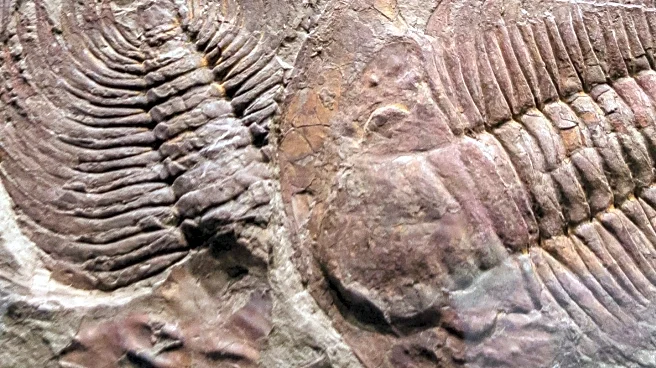What's Happening?
Swindon Museum and Art Gallery has acquired a fossilized vertebra from the first scientifically discovered stegosaur, which will be featured in a new temporary exhibition. The fossil, originally found
in Swindon in the 1870s, was previously housed at the Natural History Museum in London. The exhibition, titled 'Fossils Hunters: Unlocking Swindon's Jurassic Past,' focuses on Swindon during the Jurassic period, approximately 150 million years ago. It includes various marine fossils such as ammonites and pliosaurs, alongside the stegosaur vertebra. Elaine Arthurs, a curator at the museum, highlighted Swindon's rich fossil history, noting its popularity among Victorian fossil hunters. The exhibition aims to showcase the area's prehistoric marine life and the unique circumstances that led to the preservation of land-dwelling dinosaurs like the stegosaur.
Why It's Important?
The acquisition and display of the stegosaur fossil at Swindon Museum and Art Gallery is significant for both scientific and educational purposes. It provides an opportunity for the public to engage with paleontological history and understand the region's prehistoric environment. The exhibition not only highlights the rich fossil heritage of Swindon but also contributes to the broader understanding of the Jurassic period's biodiversity. By showcasing these fossils, the museum enhances public awareness of paleontology and encourages interest in natural history. This development also underscores the importance of preserving and studying fossils to gain insights into Earth's ancient past.
What's Next?
The exhibition 'Fossils Hunters: Unlocking Swindon's Jurassic Past' will be open to the public until April 11, 2026. During this period, the museum expects to attract visitors interested in paleontology and natural history. The exhibition may also inspire further research into the region's fossil record and potentially lead to new discoveries. As the museum continues to display these significant fossils, it may collaborate with other institutions to expand its collection and enhance educational programs. The exhibition's success could encourage similar initiatives in other regions with rich fossil histories.
Beyond the Headlines
The exhibition raises intriguing questions about the preservation of land-dwelling dinosaurs in marine environments. The stegosaur's presence in Swindon's fossil record suggests complex interactions between land and sea during the Jurassic period. This phenomenon invites further exploration into the geological and environmental conditions that facilitated such preservation. Additionally, the exhibition highlights the ethical considerations of fossil acquisition and the importance of responsible stewardship in paleontology.












